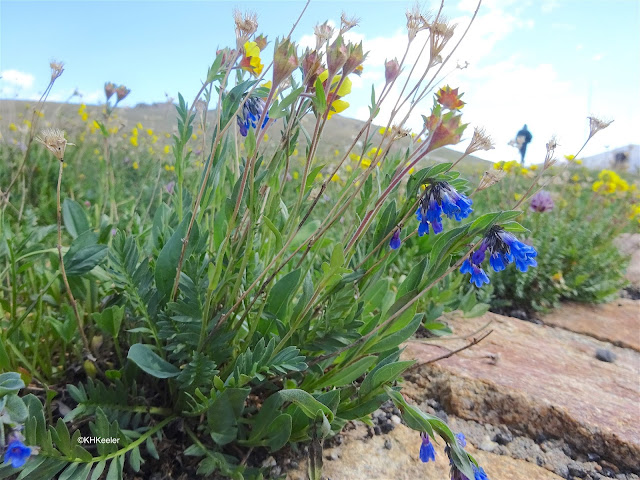Tundra is the ecosystem where it is too cold for trees. It can be too cold because the growing season is too short or because the soil is frozen (permafrost) much of the time and, in the brief periods when it is not frozen, shifts, knocking trees over, usually both. Tundra is found in the Arctic (in the Antarctic, ocean fills the area that would have tundra) and high on mountains. It is the coldest ecosystem on earth.
 |
| alpine tundra is above the highest trees |
Ecologists try to reduce the world's ecosystems to a minimum number. Of land ecosystems, called biomes, they can be reduced to forest, grassland, desert, and tundra. For people in the lower 48 United States, tundra is hardest biome to see. There is no arctic tundra in the lower 48 and alpine tundra occurs only on the tops of mountains. There are areas of alpine tundra high in the mountains of New York and New England, a chain of spots of tundra along the Rocky Mountains above 10,500 feet, and a similar chain of tundra when you get high enough in the Sierras and Cascades. Rocky Mountain National Park has the most accessible alpine tundra, because Trail Ridge Road will let you drive right up to it. And it is pretty extensive, something like 149 square miles in all the park (though some of it is way too steep for people or on an isolated peak). I wanted to see all the biomes of the world. Tundra was the last of the four I reached.
 |
| tundra in Rocky Mountain National Park (all that brown above tree line) |
It is mid September and the alpine zone in Rocky Mountain National Park is under several feet of snow. The very short growing season there, about three months, 90 days, is over. Trail Ridge Road is closed for the winter. Of course animals prowl, from elk to ptarmigan, and dwarfed conifers do a little photosynthesis on nice days, but often, from now until June, it is a bleak place, with bitterly cold temperatures and strong winds.
 |
| The alpine zone in Rocky Mountain National Park September 8, 2020, photo from Rocky Mountain National Park Facebook Post --that road is closed to the public |
This post looks back at the alpine tundra in the middle of the growing season, in late July, walking easily-accessible places at the top of Rocky Mountain National Park.
This is the alpine tundra. Tundra is the biome too cold for trees, while alpine indicates that is due to elevation, not being close to the poles. Within alpine tundra there is variation, just like in other biomes: wet areas, dry areas, protected areas, exposed areas, etc. The alpine plants are miniaturized, though, due to the short growing season and severe conditions, and the different habitats are easily overlooked.
The landscape seems bleak until you get down to the level of the plants (less than 8" tall). Aren't they gorgeous?! 
I took the photos above while standing in a road cut, which brought the ground up about four feet and made it easy to photograph the plants.
You don't have to know anything about them to enjoy their colors and shapes. But their adaptations to the world's coldest ecosystem are fascinating. I'll write about surviving in the alpine tundra next post.
Comments and corrections welcome.
Kathy Keeler, A Wandering Botanist
More at awanderingbotanist.com
Join me on Facebook: https://www.facebook.com/AWanderingBotanist





First time reading this blog, thanks for sharing
ReplyDelete